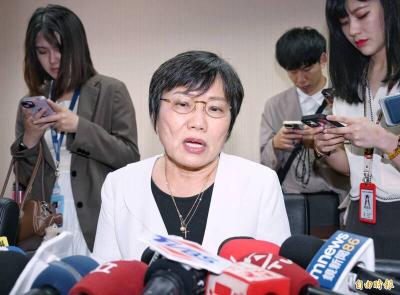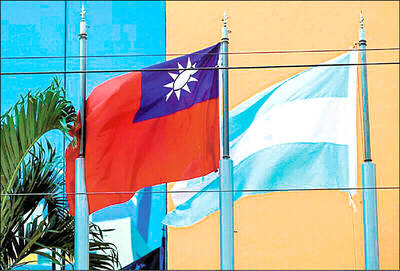Travelers will probably not get lost as easily at Taiwan Taoyuan International Airport anymore because the Taoyuan International Airport (TIA) Corp is in the process of replacing the signs at its first and second terminals with ones with clearer directions.
TIA president Samuel Lin (林鵬良) said the airport company has listed sign improvement as one of its most important projects this year. He said the current airport signs lack consistency in style. Some of them have pointed flight passengers in the wrong direction because they were placed in inappropriate locations, he said.
When the government began to renovate the first terminal in 2009, Lin said that the company hoped to simultaneously push for more user-friendly signs with consistent designs.
To facilitate replacing the signs, Lin said that the company decided to learn from Hong Kong International Airport because a large percentage of passengers in Taiwan and Hong Kong overlap. Customers will feel more at home if they see similar signs at these airports, he said.
Lin said the CEO of Hong Kong International Airport gave two free lectures to the employees of Taoyuan airport.
“Both airports [Taiwan and Hong Kong] have their signs displayed in both English and traditional Chinese characters,” Lin said. “The airport in Hong Kong has accumulated many years of experience since it was officially opened in 1998 before it decided to change to the current design three years ago. We could use their signs as a reference.”
Currently, the signs in Taoyuan airport are either yellow or white print on a black background.
Lin said the signs in the Taoyuan airport will be displayed in white print on a blue background. Those for airport facilities, such as restrooms and restaurants, will have white print on a dark red background instead.
Because some traditional -Chinese characters look similar if they are viewed from a distance, such as the Chinese words for “garden” (園) and “country” (國), Lin said that the Hong Kong Airport has decided to have the Chinese characters printed in “Imitation Song” style (仿宋體), which is a script typeface modeled after the characters used during the Southern Song Dynasty.
“[Because of the change in font] Passengers can clearly see the words on the signs even if they view them from 30m away,” Lin said, adding that Taiwan will also adopt the “Imitation Song” style for the new signs.
Lin said airport passengers could start seeing the new signs displayed at the first terminal in August. All the signs in the first and second terminals will be changed by the end of next year.

Chinese Nationalist Party (KMT) Chairman Eric Chu (朱立倫), spokeswoman Yang Chih-yu (楊智伃) and Legislator Hsieh Lung-chieh (謝龍介) would be summoned by police for questioning for leading an illegal assembly on Thursday evening last week, Minister of the Interior Liu Shyh-fang (劉世芳) said today. The three KMT officials led an assembly outside the Taipei City Prosecutors’ Office, a restricted area where public assembly is not allowed, protesting the questioning of several KMT staff and searches of KMT headquarters and offices in a recall petition forgery case. Chu, Yang and Hsieh are all suspected of contravening the Assembly and Parade Act (集會遊行法) by holding

PRAISE: Japanese visitor Takashi Kubota said the Taiwanese temple architecture images showcased in the AI Art Gallery were the most impressive displays he saw Taiwan does not have an official pavilion at the World Expo in Osaka, Japan, because of its diplomatic predicament, but the government-backed Tech World pavilion is drawing interest with its unique recreations of works by Taiwanese artists. The pavilion features an artificial intelligence (AI)-based art gallery showcasing works of famous Taiwanese artists from the Japanese colonial period using innovative technologies. Among its main simulated displays are Eastern gouache paintings by Chen Chin (陳進), Lin Yu-shan (林玉山) and Kuo Hsueh-hu (郭雪湖), who were the three young Taiwanese painters selected for the East Asian Painting exhibition in 1927. Gouache is a water-based

Taiwan would welcome the return of Honduras as a diplomatic ally if its next president decides to make such a move, Minister of Foreign Affairs Lin Chia-lung (林佳龍) said yesterday. “Of course, we would welcome Honduras if they want to restore diplomatic ties with Taiwan after their elections,” Lin said at a meeting of the legislature’s Foreign Affairs and National Defense Committee, when asked to comment on statements made by two of the three Honduran presidential candidates during the presidential campaign in the Central American country. Taiwan is paying close attention to the region as a whole in the wake of a

OFF-TARGET: More than 30,000 participants were expected to take part in the Games next month, but only 6,550 foreign and 19,400 Taiwanese athletes have registered Taipei city councilors yesterday blasted the organizers of next month’s World Masters Games over sudden timetable and venue changes, which they said have caused thousands of participants to back out of the international sporting event, among other organizational issues. They also cited visa delays and political interference by China as reasons many foreign athletes are requesting refunds for the event, to be held from May 17 to 30. Jointly organized by the Taipei and New Taipei City governments, the games have been rocked by numerous controversies since preparations began in 2020. Taipei City Councilor Lin Yen-feng (林延鳳) said yesterday that new measures by